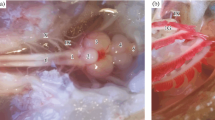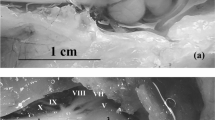Abstract
The fish heart is a unique model to compare the resistance to hypoxia of its two chambers (atrium and ventricle), which are different in the structure and functional loads. The activity of oxydoreductases malate dehydrogenase (MDH, 1.1.1.37) and lactate dehydrogenase (LDH, 1.1.1.27), as well as the parameters of the adenylate system in the heart chambers of a Black Sea scorpaena, were studied under acute hypoxia (0.9–1.2 mg O2·L–1, 90 min). Despite the leading functional role of the ventricle, MDH activity in this heart compartment tended to decrease compared to the atrium in the absence of differences in LDH activity. At the same time, the difference in the level of adenylates (ATP, ADP, AMP), total adenylate pool (AP), and adenylate energy charge (AEС) between the atrium and ventricle was statistically nonsignificant, although the absolute value of the ventricular AP was almost twice as large as the atrial AP. The AEC values of the atrium and ventricle perfused only with venous blood did not exceed ~0.7 (vs. the maximum of this parameter ~0.9–1.0), apparently reflecting the energy status of tissues initially adapted to hypoxia. Under acute hypoxia, there were found two strategies for energy metabolism transformation in the heart chambers in the form of a 2.4-fold drop in MDH activity (р < 0.05) in the atrium and a 2.2-fold increment in LDH activity (р < 0.05) in the ventricle. Probably, the decline in MDH activity in the atrial tissue was determined by a more passive function of this heart chamber in providing the blood flow. The exposure to acute hypoxia led to a decrease in the level of adenylate nucleotides and an AEC decline in the heart chambers, as pronounced most distinctly in the ventricular myocardium. When decreasing PO2, the AEC in the heart chambers shifted within quite a narrow range (from 0.7 to 0.6), indicating the retention of a certain stationary energy status achieved by inhibition of ATP consumption or demand. The putative mechanism for retaining the AEC may be based on the negative chronotropic effect of hypoxia.



Similar content being viewed by others
REFERENCES
Driedzic WR (1992) Cardiac energy metabolism. Fish Physiology 12:219–266. https://doi.org/10.1016/S1546-5098(08)60335-0.
Hochachka PW, Somero GN (2002) Biochemical Adaptation: Mechanism and Process in Physiological Evolution. Oxford University Press, Oxford. 356 pp.
Volosovets AP (2012) Optimization of astenia pharmacotherapy in the practice of modern pediatrics. The pediatrician practice. 2: 23–28 (in Russ.)
Soldatov AA, Golovina IV, Kolesnikova EE, Sysoeva IV, Sysoev AA, Kukhareva TA, Kladchenko ES (2020) Activity of Energy Metabolism Enzymes and ATP Content in the Brain and Gills of the Black Sea Scorpionfish Scorpaena porcus under Short-Term Hypoxia. J Evol Biochem Physiol 56(3):224–234. https://doi.org/10.31857/S0044452920010143
Kolesnikova EE, Golovina IV (2020) Oxidoreductase Activities in Oxyphilic Tissues of the Black Sea Ruff Scorpaena porcus under Short-term Hydrogen Sulfide Loading. J Evol Biochem Physiol 56(5):459–470. https://doi.org/10.1134/S0022093020050099
Yamauchi A (1980) Fine Structure of Fish Heart. In: Bourne GH (eds). The Hearts and Heart-like Organs. Academic Press, New York. 119–148.
Grimes AC, Kirby ML (2009) The outflow tract of the heart in fishes: anatomy, genes and evolution. Fish Biol 74(5):983-1036. https://doi.org/10.1111/j.1095-8649.2008.02125.x
Garofalo F, Imbrogno S, Tota B, Amelio D (2012) Morpho-functional characterization of the goldfish (Carassius auratus L.) heart. Comp Biochem Physiol 163(2):215-22. https://doi.org/10.1016/j.cbpa.2012.05.206
Holm-Hansen O, Booth CR (1966) The measurement of adenosine triphosphate in the Ocean and its ecological significance. Limnol Oceanogr 11(4):510–519. https://doi.org/10.4319/lo.1966.11.4.0510
Atkinson DE (1968) The energy charge of the adenylate pools as a regulatory parameter. Interaction with feedback modifiers. Biochemistry 7(11):4030–4034. https://doi.org/10.1021/bi00851a033
Ostadal B (2014) Hypoxia and the heart of poikilotherms. Curr Res Cardiol 1(1):28-32.
Farrell AP, Jones DR (1992) The heart. In: Hoar WS, Randall DJ, Farrell AP (eds) Fish Physiology. vol. XIIA. Academic Press, San Diego. 1–73.
Tota B, Cerra MC, Gattuso A (2010) Catecholamines, cardiac natriuretic peptides and chromogranin A: evolution and physiopathology of a ‘whip-brake’ system of the endocrine heart. J Exp Biol 213:3081-3103. https://doi.org/10.1242/jeb.027391
Tota B, Cimini V, Salvatore G, Zummo G (1983) Comparative study of the arterial and lacunary systems of the ventricular myocardium of elasmobranchs and teleost fishes. Am J Anat 167(1):15–32. https://doi.org/10.1002/aja.1001670103
Childress JJ, Somero GN (1979) Depth-Related Enzymic Activities in Muscle, Brain and Heart of Deep-Living Pelagic Marine Teleosts. Mar Biol 52:273–283.
Eddy FB (1974) Blood gases of the tench (Tinca tinca) in well aerated and oxygen-deficient waters. J Exp Biol 60:71–83.
Tessadori F, van Weerd JH, Burkhard SB, Verkerk AO, de Pater E, Boukens BJ, Vink A, Christoffels VM, Bakkers J (2012) Identification and functional characterization of cardiac pacemaker cells in zebrafish. PLoS One 7(10): e47644. https://doi.org/10.1371/journal.pone.0047644
Almeida-Val VMF, Hochachka PW (1995) Air-breathing fishes: metabolic biochemistry of the first diving vertebrates. Biochemistry and Molecular Biology of Fishes 5:45–55. https://doi.org/10.1016/S1873-0140(06)80029-9
Ewart HS, Driedzic WR (1987) Enzymes of energy metabolism in salmonid hearts: spongy versus cortical myocardia. Can J Zool 65(3):623–627. https://doi.org/10.1139/z87-097
Filho DW (2007) Reactive Oxygen Species, Antioxidants and Fish Mitochondria. Front Biosci 12:1229–37. https://doi.org/10.2741/2141
Bailey JR, Sephton DH, Driedzic WR (1990) Oxygen uptake by isolated perfused fish hearts with differing myoglobin concentrations under hypoxic conditions. J Mol Cell Cardiol 22(10):1125–34. https://doi.org/10.1016/0022-2828(90)90076-e
Bailey JR, Driedzic WR (1988) Perfusion-independent oxygen extraction in myoglobin-rich hearts. J Exp Biol 135(1):301–315.
Lyzlova SN, Panteleeva NS, Yuzhakova GA (1967) Biochemical topography of adenine nucleotides in the heart. Ukrainian Biochem J 39(2):156–161 (in Russ.)
Love RM (1976) Chemical Biology of Fish. Food industry, Moscow. 349pp. (in Russ.)
Christensen M, Hartmund T, Gesser H (1994) Creatine kinase, energyrich phosphates and energy metabolism in heart muscle of different vertebrates. J Comp Physiol 164:118-23. https://doi.org/10.1007/bf00301652
Kumar A, Gopesh A (2015) Effect of Hypoxia and Energy Conservation Strategies in the Air-Breathing Indian Catfish, Clarias batrachus. Natl Acad Sci Lett 38(2):135–137. https://doi.org/10.1007/s40009-014-0332-6
Chippari-Gomes AR, Gomes LC, Lopes NP, Val AL, Almeida-Val VMF (2005) Metabolic adjustments in two Amazonian cichlids exposed to hypoxia and anoxia. Comp Biochem Physiol 141:347–355. https://doi.org/10.1016/j.cbpc.2005.04.006
Hochachka PW, Somero GN (1984) Biochemical Adaptation. Princeton Univ Press, New Jersey, 560 pp.
Sollid J, Nilsson GE (2006) Plasticity of respiratory structures—adaptive remodeling of fish gills induced by ambient oxygen and temperature. Resp Physiol Neurobiol 154:241-251. https://doi.org/10.1016/j.resp.2006.02.006
Farrell AP (2007) Tribute to P.L. Lutz: A Message From the Heart—Why Hypoxic Bradycardia in Fishes? J Exp Biol 210(Pt 10):1715–25. https://doi.org/10.1242/jeb.0278
Zverev AA, Anikina TA, Iskakov NG, Leonov NV, Zefirov TL (2018) ATF inhibits spontaneous atrial contraction in rats. Scientific notes of Kazan University 160(4):558–567 (in Russ.)
Rostovtseva TK, Bezrukov SM (1998) ATP transport through a single mitochondrial channel, VDAC, studied by current fluctuation analysis. Biophys J 74:2365–2373. https://doi.org/10.1016/S0006-3495(98)77945-7
Kawano S, Kuruma A, Hirayama Y, Hiraoka M (1999) Anion permeability and conduction of adenine nucleotides through a chloride channel in cardiac sarcoplasmic reticulum. J Biol Chem 274:2085–2092. https://doi.org/10.1074/jbc.274.4.2085
Anikina TA, Bilalova GA, Zverev AA, Sitdikov FG (2007) Effect of ATP and its analogs on contractility of rat myocardium during ontogeny. Bull Exp Biol Med 144(1):4–7. https://doi.org/10.1007/s10517-007-0239-z
Gessi S, Merighi S, Varani K, Borea PA (2011) Adenosine receptors in health and disease. Adv Pharmacol 61:41–75. https://doi.org/10.1016/B978-0-12-385526-8.00002-3
Funding
This work was implemented within a governmental assignment No. 0556-2021-0003 to the A.O. Kovalevsky Institute of Biology of the Southern Seas, and supported by the Russian Foundation for Basic Research grant No. 20-44-920001.
Author information
Authors and Affiliations
Contributions
E.E.K.: task setting, preparation of fish heart chambers, writing and editing the manuscript; A.A.S.: pivotal idea, task setting, experimental design, writing and editing the manuscript; I.V.G.: assaying enzyme activities, statistical data processing, preparing illustrations, writing and editing the manuscript; I.V.S. and A.A.S.: assaying adenyl nucleotides, statistical data processing; T.A.K.: participation in experiments.
Corresponding author
Ethics declarations
COMPLIANCE WITH ETHICAL STANDARDS
All applicable international, national and institutional principles of handling and using experimental animals for scientific purposes were observed.
This study did not involve human subjects as research objects.
CONFLICT OF INTEREST
The authors declare that they have neither evident nor potential conflict of interest related to the publication of this article.
Additional information
Translated by A. Polyanovsky
Russian Text © The Author(s), 2021, published in Zhurnal Evolyutsionnoi Biokhimii i Fiziologii, 2021, Vol. 57, No. 5, pp. 420–429https://doi.org/10.31857/S0044452921050089.
Rights and permissions
About this article
Cite this article
Kolesnikova, E.E., Soldatov, А.А., Golovina, I.V. et al. Activity of Energy Metabolism Enzymes and the Adenylate System in Heart Chambers of a Black Sea Scorpionfish (Scorpaena porcus L.) under Acute Hypoxia. J Evol Biochem Phys 57, 1050–1059 (2021). https://doi.org/10.1134/S0022093021050070
Received:
Revised:
Accepted:
Published:
Issue Date:
DOI: https://doi.org/10.1134/S0022093021050070




